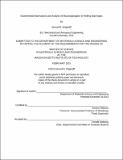| dc.contributor.advisor | Antoine Allanore. | en_US |
| dc.contributor.author | Wagstaff, Samuel R | en_US |
| dc.contributor.other | Massachusetts Institute of Technology. Department of Materials Science and Engineering. | en_US |
| dc.date.accessioned | 2015-09-02T15:17:04Z | |
| dc.date.available | 2015-09-02T15:17:04Z | |
| dc.date.copyright | 2015 | en_US |
| dc.date.issued | 2015 | en_US |
| dc.identifier.uri | http://hdl.handle.net/1721.1/98314 | |
| dc.description | Thesis: S.M., Massachusetts Institute of Technology, Department of Materials Science and Engineering, 2015. | en_US |
| dc.description | This electronic version was submitted by the student author. The certified thesis is available in the Institute Archives and Special Collections. | en_US |
| dc.description | Cataloged from student-submitted PDF version of thesis. | en_US |
| dc.description | Includes bibliographical references (pages 45-47). | en_US |
| dc.description.abstract | The increased demand for aluminum as a primary structural metal stems from a quest in automotive, aerospace, and marine industries to be more energy efficient and sustainable. This unprecedented demand drives aluminum casting methods towards increased productivity looking to, cast larger ingots faster. The unfortunate consequence of this approach is an enhanced variation of metallurgical properties over the cross section of slab ingots. Rolling slab ingots of AlCu4.5 using a typical Direct-Chill casting technique have been cast and sectioned for analysis. This alloy allowed us to compare our results with the available literature and to elucidate the marked differences in spatial variation of microstructure and composition found in radial and lateral symmetry castings. In an attempt to couple conventional theory with our results, sump and temperature profiles were measured in-situ and modeled using a commercial finite element analysis software package. The combination of experimental and modeling results indicate that the variations in the cooling parameters through the cross section are largely responsible for the spatial variances in metallurgical properties, pointing to a possible refinement of DC casting parameters. | en_US |
| dc.description.statementofresponsibility | by Samuel R. Wagstaff. | en_US |
| dc.format.extent | 47 pages | en_US |
| dc.language.iso | eng | en_US |
| dc.publisher | Massachusetts Institute of Technology | en_US |
| dc.rights | M.I.T. theses are protected by copyright. They may be viewed from this source for any purpose, but reproduction or distribution in any format is prohibited without written permission. See provided URL for inquiries about permission. | en_US |
| dc.rights.uri | http://dspace.mit.edu/handle/1721.1/7582 | en_US |
| dc.subject | Materials Science and Engineering. | en_US |
| dc.title | Experimental observations and analysis of macrosegregation in rolling slab ingots | en_US |
| dc.type | Thesis | en_US |
| dc.description.degree | S.M. | en_US |
| dc.contributor.department | Massachusetts Institute of Technology. Department of Materials Science and Engineering | |
| dc.identifier.oclc | 918897438 | en_US |
